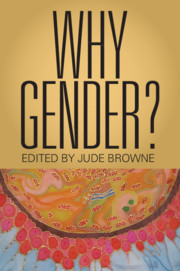Book contents
- Why Gender?
- Why Gender?
- Copyright page
- Dedication
- Contents
- Figures
- Tables
- Contributors
- A Prefatory Note
- Acknowledgements
- Introduction
- Chapter 1 Gender in Translation: Beyond Monolingualism
- Chapter 2 Gender and the Queer/Trans* Undercommons
- Chapter 3 Gender and the End of Biological Determinism
- Chapter 4 Gender, Sexuality, Race, and Colonialism
- Chapter 5 Posthuman Feminism and Gender Methodology
- Chapter 6 Gender, Sperm Troubles, and Assisted Reproductive Technologies
- Chapter 7 Gender, Capital, and Care
- Chapter 8 Aspiration Management: Gender, Race, Class, and the Child as Waste
- Chapter 9 Gender, Race and American National Identity: The First Black First Family
- Chapter 10 Gender and the Collective
- Chapter 11 Willfulness, Feminism, and the Gendering of Will
- Chapter 12 Gender and Emigré Political Thought: Hannah Arendt and Judith Shklar
- Chapter 13 Feminism and the Abomination of Violence: Gender Thought and Unthought
- Chapter 14 Trafficking, Prostitution, and Inequality: The Centrality of Gender
- Chapter 15 Gender, Revenge, Mutation, and War
- Chapter 16 Bed Peace and Gender Abnorms
- Index
- References
Chapter 10 - Gender and the Collective
Published online by Cambridge University Press: 15 October 2021
- Why Gender?
- Why Gender?
- Copyright page
- Dedication
- Contents
- Figures
- Tables
- Contributors
- A Prefatory Note
- Acknowledgements
- Introduction
- Chapter 1 Gender in Translation: Beyond Monolingualism
- Chapter 2 Gender and the Queer/Trans* Undercommons
- Chapter 3 Gender and the End of Biological Determinism
- Chapter 4 Gender, Sexuality, Race, and Colonialism
- Chapter 5 Posthuman Feminism and Gender Methodology
- Chapter 6 Gender, Sperm Troubles, and Assisted Reproductive Technologies
- Chapter 7 Gender, Capital, and Care
- Chapter 8 Aspiration Management: Gender, Race, Class, and the Child as Waste
- Chapter 9 Gender, Race and American National Identity: The First Black First Family
- Chapter 10 Gender and the Collective
- Chapter 11 Willfulness, Feminism, and the Gendering of Will
- Chapter 12 Gender and Emigré Political Thought: Hannah Arendt and Judith Shklar
- Chapter 13 Feminism and the Abomination of Violence: Gender Thought and Unthought
- Chapter 14 Trafficking, Prostitution, and Inequality: The Centrality of Gender
- Chapter 15 Gender, Revenge, Mutation, and War
- Chapter 16 Bed Peace and Gender Abnorms
- Index
- References
Summary
Gender inequality is perhaps the deepest form of persisting inequality we face today, especially as it intersects with inequalities of class, caste and race. It adversely affects not just a country’s economy but also its social and political fabric. Indeed, gender inequality is embedded in all our major institutions – the family, the market, the community and the State. Not surprisingly, a gender lens gives us insights into the world we live in which are rarely obtainable otherwise. Many aspects of gender inequality are visible, but many others remain hidden within gendered social norms and biased perceptions, as several other authors of this volume have also noted (for example, Nancy Fraser, Judith Butler, Jack Halberstam and Sara Ahmed). These norms and perceptions, in turn, lead to unequal outcomes for women in multiple arenas.
- Type
- Chapter
- Information
- Why Gender? , pp. 219 - 244Publisher: Cambridge University PressPrint publication year: 2021



